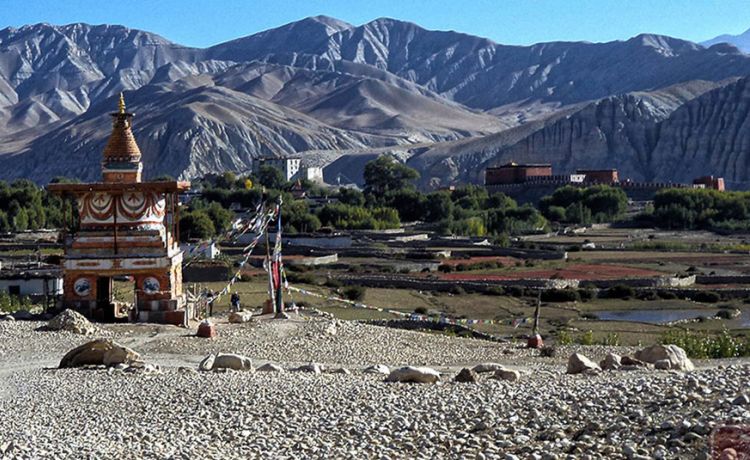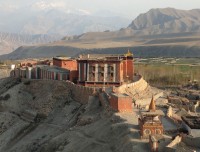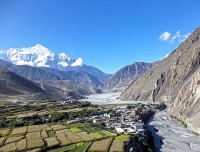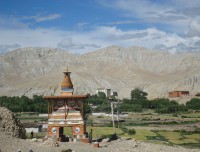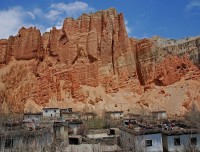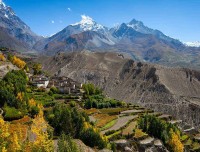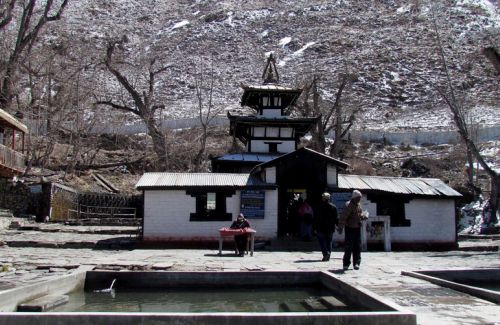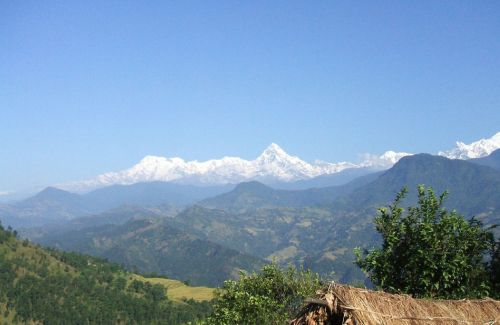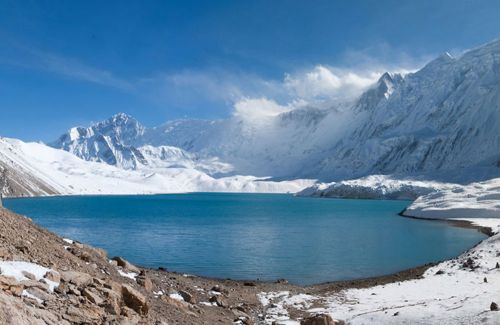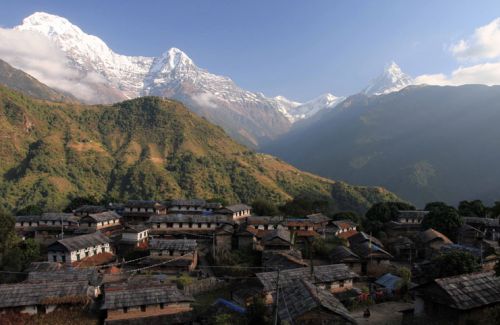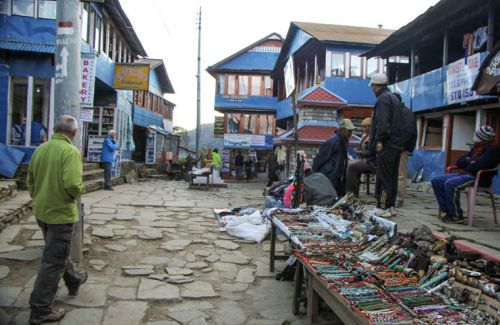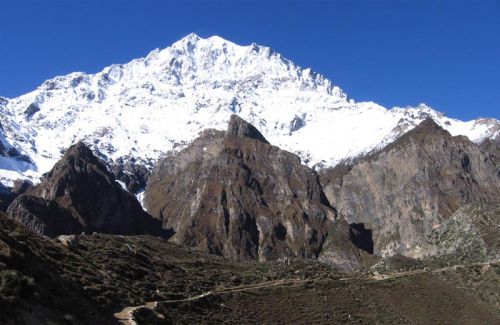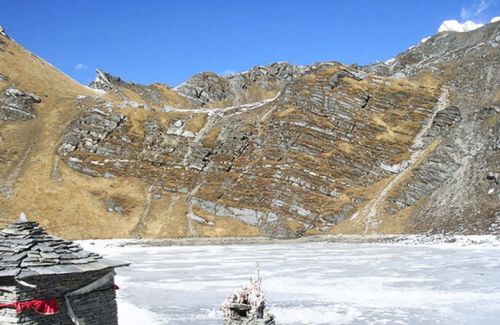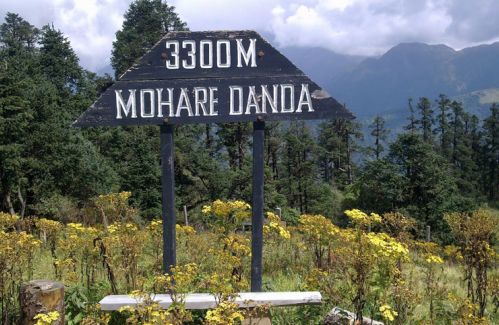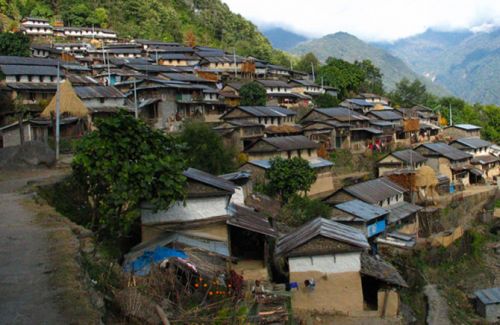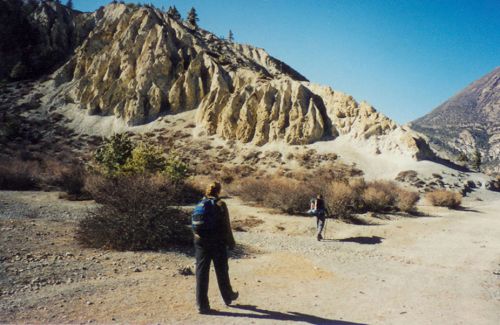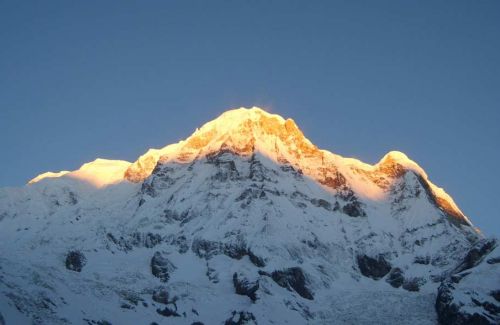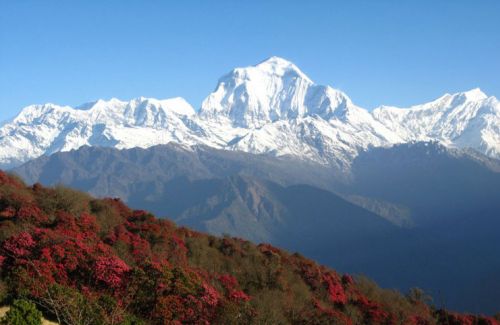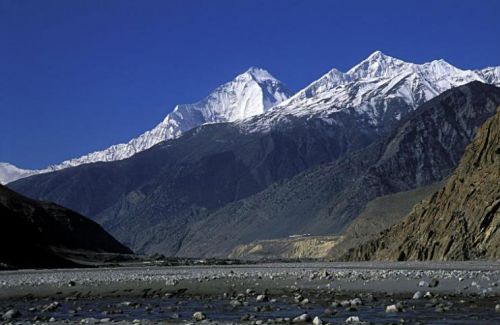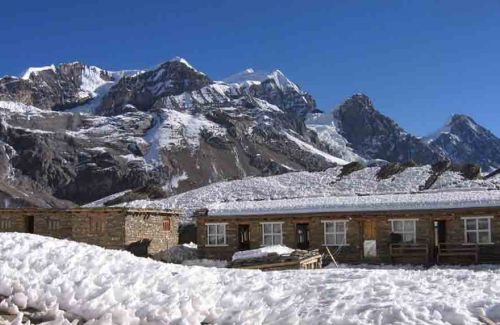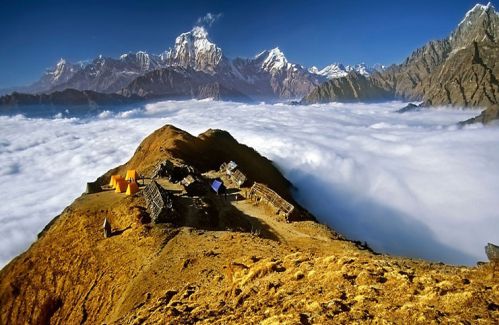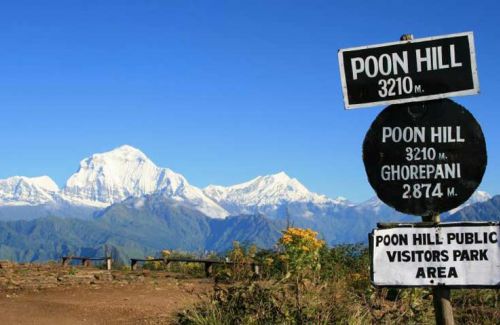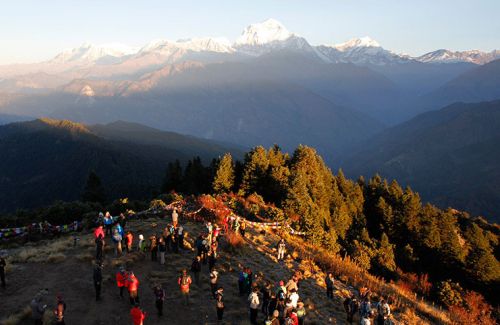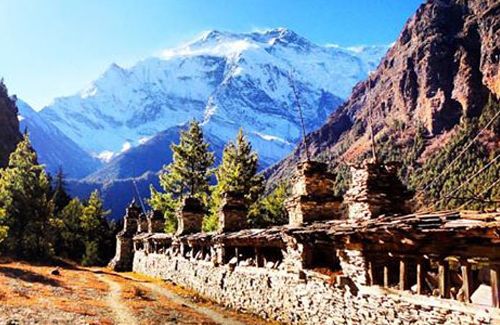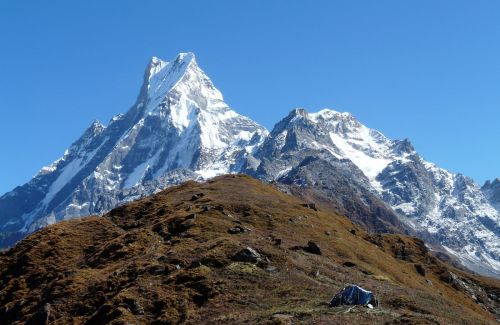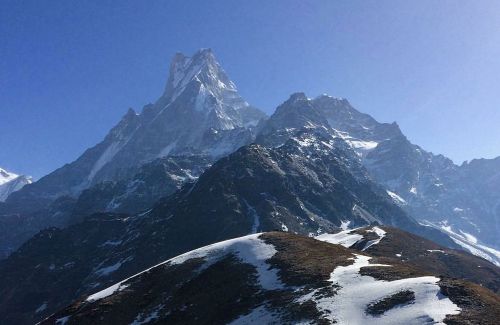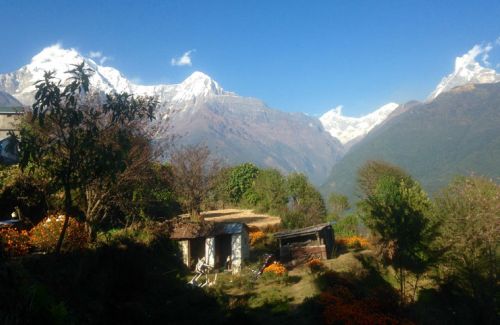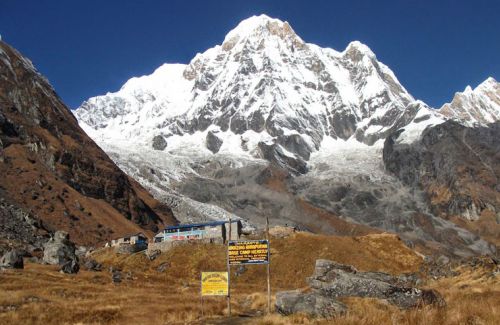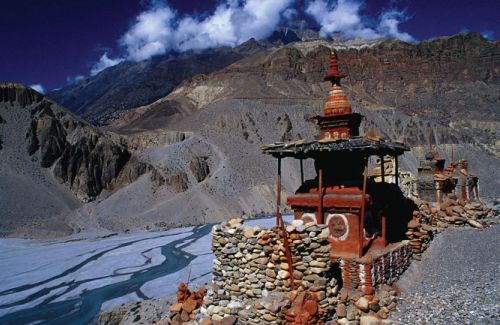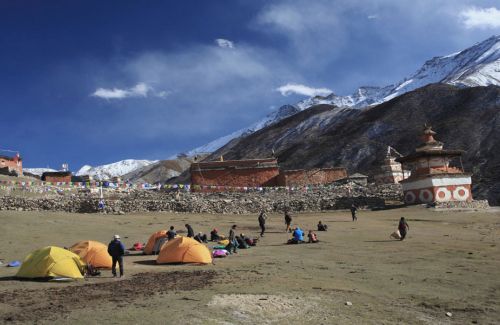Upper Mustang Trekking
- Duration17 Days
- Max. Altitude4,200 m
- Starts FromUSD 2400
Destination:Nepal
Trip Grade:Moderate (**)
Meals:Breakfast + Lunch + Dinner
Transportation:Private Vehicle/Tourist Bus
Accommodation:Lodge
Best Season:February to May & September to December/Trek can be done in the Monsoon too.
Show AllUpper Mustang Trekking is known as the hidden treasure, the remote Trans-Himalayan Region. The other name of this area is Lo. Lo was a part of Tibetan region. So, in Upper Mustang, there is an influence of Tibetan Buddhism, culture and their life styles. The people of Upper Mustang call themselves Loba, the leader of their community would be designated as a king. The locals show their deep respect to him. Still not only the culture but also the landscape seem similar like of Tibet highland. Mustang is in the rain shadow area of Dhaulagiri, encircled by rocks, completely isolated barren landscape of bizarre formations. Therefore, we can explore the monasteries, caves, local tribes and scenic beauty of the different landscapes. The houses of Upper Mustang are made up of stone and sun baked bricks. The whitewashed houses have collected firewood tucked in the roof. Mustangis have their unique family life. All the brothers in the family have a single wife, a practice of polyandry.
Upper Mustang was the restricted region till October 1991 for the foreigners so that it is still known as the Last Forbidden Kingdom. One should get a special permit to enter this area valid your permit for 10 days and each additional days cost extra money. The trail follows the traditional salt trade route to Tibet from the lowlands. Lo-Mangthang is the capital of Upper Mustang, a medieval town which has been surrounded by the huge town wall and the remarkable architecture is four stored palace of this place. We can get the better barren landscape view from Lo La Pass. Another attraction of Upper Mustang is the Tiji festival, which is celebrated in the late winter, with the ending of the dry season.
We can take an early flight to Jomsom from Pokhara then the journey starts. The trail heads towards to Ekali Bhatti village and to Kagbeni which lies on the bank of two rivers. On the way along the river , we go through Tange village with narrow alleys among white washed houses. We climb to Taklam La Pass through plateaus from where magnificent views of Tilicho peak, Yakawa Kang and Damodar Danda can be seen. A three hours long walk takes us to the small village of Samar then we again trek to Syangbochhen. Trek uphill takes us to Yamda La. After Nyi Pass, we descend to Ghyami, the third largest village in the low region. The crossing of Ghyami Khola takes us to the village of Charang. The trail then leads us towards Lo-Mangthang with magnificent view of Nilgiri, Tilicho, Annapurna I and Bhrikuti Peak. The best time to trek this reason is from April to November. We can trek Upper Mustang even in the monsoon season as well because this is the rain shadow region and the least rainfall area of Nepal.
Himkala Adventure has carved out for itself an enviable niche at the summit of the best trekking company. We have earned the place of pride through the vision and dedication of a team, caring and guests’ interest focused services. We have our guides possessed cutting edge knowledge in guiding and showing confidence and cordiality in any difficult circumstances as well.
Trip Highlights
- Visiting UNESCO World Heritage Sites in Kathmandu
- Scenic drive from Prithivi Highway through countryside roads
- Enchanting Pokhara Valley - the city of Lakes
- Exciting flight from Pokhara - Jomsom - Pokhara
- Exploration of Kingdom with the kingdom - Mustang
- Discover many caves and amazing landscape
- Experience the wonderful Tibetan culture and their life style
- Visit Muktinath - the plgrimage site of both Hindus and Buddhists
- Upper Mustang, the hidden treasure, inhabited by Lo
- Landscape is similar to the Tibetan highland,Landscape of bizarre formations
- Going through Taklam La Pass
- Wonderful Mountain Vistas of Annapurna and Dhaulagiri
Day to Day Itinerary
Day 01:Arrival in Kathmandu (1,350 m) & Transfer to Hotel. Overnight at Hotel
Day 02:Kathmandu Sightseeing and Trek preparation. O/N at Hotel
Day 03:Drive from Kathmandu to Pokhara (827 m), 6-7 hrs. O/N at Hotel
Day 04:Fly from Pokhara to Jomsom and trek to Kagbeni (2,858 m), 3-4 hrs. O/N at Guest House
Day 05:Trek from Kagbeni to Chele (3,050 m), 5-6 hrs. O/N at Guest House
Day 06:Trek from Chele to Syangboche (3,475 m), 6-7 hrs. O/N at Guest House
Day 07:Trek from Syangboche to Ghyami (3,520 m), 5-6 hrs. O/N at Guest House
Day 08:Trek from Ghyami to Charang (3500 m), 4-5 hrs. O/N at Guest House
Day 09:Trek from Charang to Lo- Mangthang (3700 m),5-6 hrs. O/N at Guest House
Day 10:Rest day in Lo- Mangthang. O/N at Guest House
Day 11:Trek from Lo- Mangthang to Drakmar (3,810 m), 6-7 hrs. O/N at Guest House
Day 12:Trek from Drakmar to Ghiling (3,806 m),5-6 hrs. O/N at Guest House
Day 13:Trek from Ghiling to Chhuksang (3050 m),5-6 hrs. O/N at Guest House
Day 14:Trek from Chhuksang to Jomsom (2,700 m),6-7 hrs. O/N at Guest House
Day 15:Fly from Jomsom to Pokhara, 25 min.O/N at Guest House
Day 16:Drive from Pokhara to Kathmandu, 6-7 hrs. O/N at Hotel
Day 17:Departure to International Airport
Cost Include
- Airport Picks up and Drops off by private tourist vehicle
- 3 nights in Kathmandu and 2 nights in Pokhara, twin sharing basis accommodation of 2-3 star hotel with Breakfast
- Guided City Tour with private tourist vehicle
- A government licensed holder city tour guide
- Full Board Meal (Breakfast + Lunch + Dinner) during the trek
- Lodges, Guest Houses basis accommodation during the trek
- Drive from Kathmandu - Pokhara - Kathmandu with tourist coach
- Flight from Pokhara - Jomsom - Pokhara including airport departure taxes
- An experienced English speaking Trekking Guide
- The required number of local staff and porter (2 Trekkers = 1 porter)
- Food, accommodation, salary, insurance, equipment and medical kit for all staffs
- Annapurna Conservation Area Permit, TIMS, and Special Permit for Upper Mustang Trekking
- Down Jacket, Duffel Bag, and Sleeping Bag by Himkala Adventure if required
- Farewell Dinner in Nepalese Restaurant with Cultural show
- Government Taxes, VAT, and Service Charge
Cost Exclude
- Lunch and Dinner in Kathamndu and Pokhara
- Entrance Fees in Heritage Sites and other places
- Nepal Visa fee (bring accurate USD cash and two passport photographs)
- International airfare to and from Kathmandu
- Excess baggage charges
- Extra night accommodation/s in Kathmandu (if there will be due to some reason)
- Your Travel Insurance and rescue evacuation
- Personal expenses (phone calls, laundry, bar bills, battery recharge, extra porters, bottle or boiled water, shower etc)
- Personal Trekking Equipment
- Tips for guides and porters (Tipping is expected)
- Any costs that is not mentioned in Cost Includes Section
Detail Itinerary
Day 01Arrival in Kathmandu (1,350 m) & Transfer to Hotel. Overnight at HotelUpon your arrival at Tribhuvan International airport, our representative from Himkala Adventure will greet you and transfer you to the hotel. Rest of the time you can spend on walking around Thamel. Overnight at Kathmandu
Day 02Kathmandu Sightseeing and Trek preparation. O/N at Hotel After breakfast, we commence our tour to the UNESCO World Heritage Sites. This is more informative and knowledgeable in Stupas, Palaces, Courtyards, and Hindu temples. The art and architecture are very intricate and antique. After the sightseeing, we come back to hotel and brief you about the trek Upper Mustang we start from tomorrow. Overnight at Kathmandu
Day 03Drive from Kathmandu to Pokhara (827 m), 6-7 hrs. O/N at HotelOur trip begins after our breakfast.It is 200 km on the Prithivi Highway.The road passes through hills, streams and many bridges. Kathmandu to Pokhara is a bit lengthy travel but it is an exciting journey through countryside with terraced farming lands. There are many restaurants on the way and you can stop for lunch any place you think appropriate as your guide suggests you. The view near to Pokhara is astounding. Overnight at Pokhara After breakfast, we begin to drive to Pokhara. It is 200 km on the Prithivi Highway which has smooth road full of scenic beauty.Overnight at Pokhara
Day 04Fly from Pokhara to Jomsom and trek to Kagbeni (2,858 m), 3-4 hrs. O/N at Guest House It is 20 minutes flight from Pokhara to Jomsom. It is an exciting morning flight that amazes you with the grandeur Mountain View in the clear day. It is very windy in the day time. We hike to north towards to Kagbeni, up the Kali Gandaki, the deepest gorge in the world. After this we reach to Ekali Bhatti, where we can have our lunch then proceed to Kagbeni. After checking in the hotel, we can go to explore around it.There is gumba named the Thupten Samphel Ling that houses the small statues. We can walk over the narrow passageways and the street of the fort. Overnight at Kagbeni
Day 05Trek from Kagbeni to Chele (3,050 m), 5-6 hrs. O/N at Guest House After breakfast, we leave Kagbeni and go to the steep climb up to the cliffs on the eastern side of the gorge from where we can see the great view of Kagbeni. Then, we follow the trail through the river bed and reach near to Tange, after 2 and half hours, the first real Mustang village. We again go steep down to the valley and gently up the other side. After the undulating paths, we reach to Chhusang and teke the lunch. Then following the river bed and the other side of the valley, we arrive at the bottom of the Chele, where there is a bridge. We cross the bridge over Kali Gandaki River. The last climb up to Chele is steep. Overnight at Chele
Day 06Trek from Chele to Syangboche (3,475 m), 6-7 hrs. O/N at Guest House After breakfast, we retrace back to Ekali Bhatti and cross the Taklam La Pass (3,624 m). After this, we continue our path through the plateaus and narrow stretches. The incredible views of Tilicho Peak, Damodar Danda and Yakawa Kang entice us. Our trek continues, we descend to the village named Samar.After climbing above the Samar village; we hit the ridge and again drop down to the stream. After 3 hours walk from there take us to Syangboche. We pass the cave named Ramchung on the way. Overnight at Syangboche
Day 07Trek from Syangboche to Ghyami (3,520 m), 5-6 hrs. O/N at Guest House After having breakfast, we begin our trek climbing up to Yamda La (3,850 m). We pass the Tibetan style houses with open Varanda, chortens and some tea shops. After passing passes, and barley field, we climb to Nyi Pass (4,010 m). Ultimately, we descend to the Ghaymi Village. Overnight at Ghaymi
Day 08Trek from Ghyami to Charang (3500 m), 4-5 hrs. O/N at Guest House After breakfast, we cross Ghaymi Khola, the trail climbs to a plateau and passes through the Mani wall. When we come to the end of the Mani wall, the trail heads east to the village of Charang. The sight is the blending of fields, willow trees, houses, stone walls. The white dzong and the red gompa have glorified the place. Overnight at Charang
Day 09Trek from Charang to Lo- Mangthang (3700 m),5-6 hrs. O/N at Guest House We begin our trek descending to Charang Chu Canyon first and climb steep after crossing the river. After this, we gently climb up the windy pass of Lho at an elevation of 3,850 m. When we descend towards Lo-Mangthang, the city enclosed by the old wall can be viewed well. Overnight at Lo-Mangthang
Day 10Rest day in Lo- Mangthang. O/N at Guest House The day around Lo-Mangthang can be really fruitful when we go to visit Namgyal Gompa and Tingkhar. Namgyal Gompa is not only a significant monastery but also serves as the local court for the local community. Tingkar is the main village to the northwest of Lo-Mangthang. Besides that we can visit other Gompas like: Tall Champa Lakhang, Thugchen Gompa, Chyodi Gompa, four storied Raja’s Palace and come back to hotel. Overnight at Lo-Mangthang
Day 11Trek from Lo- Mangthang to Drakmar (3,810 m), 6-7 hrs. O/N at Guest House After breakfast, we trek southwest on herder’s trail, up a side valley to the Chogo La (4,325 m).After this, we follow the grassy valley before descending through a gorgr to cross the Tsarang Khola and climb to Gyakar where there we can visit very ancient Ghar Gompa, 1200 years old monastery, The rock painting or the painted carved stones on the wall of monastery is well known of this Gompa. It is said that one wish made by anyone is fulfilled in this Gompa. Then, the trail climbs a ridge and crosses a valley to a cairn at an elevation of 4,170 m. We continue across the meadows before descending a tough ravine between towering walls of red rock to the large village of Drakmar. Numerous caves can be seen in the cliff walls. Overnight at Drakmar
Day 12Trek from Drakmar to Ghiling (3,806 m),5-6 hrs. O/N at Guest House Today, after breakfast, we continue our trek down to the valley through the dusty and windy trail. The trail goes across the arid plateau. The trail offers the beguiling views of Mt. Dhaulagiri and Nilgiri. We arrive at Ghiling and walk around the Ghiling village. Overnight at Ghiling
Day 13Trek from Ghiling to Chhuksang (3050 m),5-6 hrs. O/N at Guest House Today, after breakfast, we climb up to Syangbochen La (3,850 m) then gemtly descend to Syangbochen (3,800 m). There are two trails near to Syangbochen. The trail to the left hand side goes through the Ranchung Cave and the trail to the right hand side leads to Samar village. We follow the right hand side trail passing through Yamdo La (3,920 m), descend to Bhena La (3,860 m) and continuously descend to Samar village (3,660 m). After Samar,we climb for a while and walk down all the way through Chele to KaliGandaki. Then we trek downstream to Chhuksang. Overnight at Chhuksang
Day 14Trek from Chhuksang to Jomsom (2,700 m),6-7 hrs. O/N at Guest House From Chhuksang to Jomsom is a bit lengthy trek. Trek from Chhuksang to Kagbeni is more scenic through the sandy and windy trails. The trail goes gently up but more downhill with narrow lanes passing white washed houses, buckwheat, barly fields and apple orchards. We take the lunch at Kagbeni. It is windy in the afternoon but the walk from Kagbeni to Jomsom via Ekali Bhatti through flat and gentle downhill trail is indelibly stamped in our memory. Eventually, we cross the bridge at Kali Gandaki River and arrive at Jomsom. Overnight at Jomsom
Day 15Fly from Jomsom to Pokhara, 25 min.O/N at Guest House After breakfast, we fly back to Pokhara from Jomsom in the morning, which takes 20 minutes. We can view the Annapurna massifs, Dhaulagiri, Hiunchuli and Lamjung Himal in the good weather. After arrival in Pokhara, we go to hotel for the overnight stay. Overnight at Pokhara
Day 16Drive from Pokhara to Kathmandu, 6-7 hrs. O/N at Hotel It is about 6-7 hours drive from Pokhara to Kathmandu. The drive from Pokhara to Kathmandu is convenient in the well maintained road through the scenic countryside view. Overnight at Kathmandu
Day 17Departure to International Airport We will transfer you to the airport 3 hours prior to your scheduled flight. You could utilize your time for shopping and arranging things. We depart you in the International terminal section for your onward destination showing gratitude on that you had joined Himkala Adventure for the Upper Mustang Trek. We wish you have safe journey. Namaste with palms together
Trip FAQ
Himkala Adventure would like to quench the thirst of all necessary questions answers about Upper Mustang Trekking for all curious travelers/trekkers in the world. As you are entirely from different geographical location, you could better to know everything about the treks from the beginning i.e. airport pick up till your departure like airport picks up, drops off, accommodation in city, in the trek, guide and porters, safety for the trekking, food and accommodation and some other things that you might face on the way. Hope our endeavor listing these questions answers will help you self informed.
This is simply the outlines of the services we offer but it may differ as per your requirement, number of trekkers. What we go through our conversation, we will manage the means of transportation, hotels in the city, accommodation in the trekking, numbers of porters etc. This is general idea about Upper Mustang trekking before your trip and you become clearer about the trek. Please feel free to contact us to get more information about the trekking in the Himalayas of Nepal.
1) How is Upper Mustang Trekking in Nepal?
Upper Mustang Trekking is the popular trekking trail of Annapurna Region in the western part of Nepal.The trek reaches up to 4,200 m from the sea level. It is a moderate trek and can be done by anyone. Upper Mustang Trekking offers an incredible remote Trans-Himalayan mountain area with unique Himalayan culture influenced from Tibetan culture.Upper mUstang is refered from the high desert region of the Tibetan plateau, Kaligandaki, and to Kagbeni.This trekking offers great opportunity to explore the thousand years of old monastery, caves, local tribes and scenic beauties of the different landscapes. We begin our journey from worlds deepest gorge Kaligandaki Region into worlds highest regions of Lo-Mangthang Valley that passes through an almost tree-less barren landscape, a steep rocky trail up and down hill and panoramic views of Nilgiri, Annapurna, Dhaulagiri and several other peaks. The trek passes through high peaks, passes, glaciers, and alpine valleys. The thousands years of isolation has kept the culture, lifestyle and heritage remain unchanged for centuries and to this date. The houses in Mustang are mostly made from stone and sun baked mud bricks. The city wall and the four storey palace in Lo-Manthang are some of the beautiful architectures of Mustang region
2) What physical fitness do I need to book this trip?
Every trekking in the Himalayas of Nepal require the certain level of physical and mental fitness.So, we advise you to be in good physical shape and able to feel comfortable while hiking up and down 7 to 12 miles per day on a trail carrying a day pack of about 10 pounds. Three things could make you confident enough for any trek you would like to do: aerobic, strength and mental.
Aerobic conditioning is important primarily because you will be trekking in thinner air, up to 40% less than at sea level. With good aerobic conditioning, you will be able to better metabolize whatever oxygen is available to you. You should plan on doing at least one hour of aerobic 3 /4 times per week for 1 month or more before your arrival in Nepal. Walking, jogging, cycling, hiking on valley floor to ridge line ascents with day back are some of the excellent forms of exercise, so long as you are strengthening leg muscles and building stamina. Speed is not the essence; stamina, confidence and continuity are.
3) How do I find Himkala Adventure for my pick up at the airport?
Our representative from Himkala Adventure will display a small board of company or your name on the sheet of paper outside the airport terminal. You will be driven to the hotel by our tourist vehicle.
4) What sort of accommodation do I get in Kathmandu and Pokhara ?
Normally we provide standard rooms with twin sharing accommodations at three star or similar category hotels in Kathmandu and Pokhara including breakfast. Accommodation in these cities can be upgraded as per your request. But some of our packages are sold without accommodation in the city.
5) How are tea house facilities during Upper Mustang Trekking?
Tea House is the combination of guest house, restaurant, and social hang out. Tea houses in Jomsom Muktinath Trekking area are highly professional though they are simple but with neat and clean lodging offering fine views and plain but fresh and hygienic food with friendly atmosphere Most of the Tea Houses have running water facility. Many of them have hot water available for bathing. But we discourage our groups from using water heated by wood as lack of firewood in most villages is a big environmental concern in Nepal.
6) What sort of accommodation do I get in trekking?
Guesthouses/Tea Houses/Lodges provide twin sharing single and double rooms and occasionally a dormitory which is basically clean with a mattress and a quilt or blanket. Our company provides the sleeping bag if needed but we always recommend having your own sleeping equipments. You have to share the room with your group member or sometimes with unknown traveler. The toilet is always outside the room with basic facilities.
7) What sort of foods, water and drinks can I expect in trekking?
The foods in the Himalayas are very simple. There are mostly the family members themselves to cook and serve the meal. They are simply trained but experienced because they have been offering such services for many years in this busy route. The food is hygienic, fresh and delicious. We recommend you to drink mineral water or the boiled or using water purification pills or drops.
Most of the foods are cooked in the kitchen of tea houses. They serve you with different varieties of delicious Nepali and continental dishes. The most popular Nepali food is daal bhat (rice and lentils) with some mixed vegetable curry. Garlic soup is popular as it helps you with acclimatization. You could better be vegetarian in the mountains. All hotels in cities and guesthouses in trekking serve the vegetarian food. You can find all common types of drinks like hot chocolates, coffee, tea, hot lemon with honey, ginger tea, soft drinks etc. you will have your breakfast and dinner at the lodges where you will be staying and lunch somewhere on the way to your next destination.
8) What mode of transportation do I use?
We will provide the private transportation for Airport/Hotel/Airport pick up and drop and sightseeing in Kathmandu Valley. We use transportation as based on our cost inclusion section. The transportation varies depending on your requirements at the time of booking the trip.
9) What is the best season for this trekking?
The best season for Jomsom Muktinath Trekking is spring (March to May) and autumn (September to December). These are the perfect time of the year for the breathtaking views of Himalayas with clear and sunny days. But the weather in the mountains is unpredictable.
10) What is the weather and temperature like during the trekking?
The climate in Nepal varies from place to place which can be categorized in different four main seasons. The main seasons in Nepal are spring (March to May), summer (June to August), autumn (September to November) & winter (December to February). The best season to travel in Nepal is autumn (September, October & November) & spring (March, April & May). Weather in the mountains is unpredictable. But the day temperature in the Upper Mustang Trekking is comfortable.
11) Who will be guiding me during this trip?
We provide the professional government license holder English speaking trekking guides for our entire trekking trip. We can also provide French, Spanish, Japanese, German or Italian speaking guides as per your preference with extra payment but not guaranteed. All guides will be Nepali people who are carefully selected on the basis of their appropriate experience, leadership skills and personality. They are all trained from Nepal Academy of Tourism and Hotel Management, certified and approved by the Tourism Department of Nepal government. We provide a different city tour guide to guide you in UNESCO World Heritage Sites in Kathmandu. They are the professional license holder guide specialized in culture, history, geography, iconography, archeology and religion with good command over English. Tour guides are specialized in city tour and trekking guides are more in the hiking and trekking in the Himalayas.
12) What sort of experience do your guides have?
Our entire city tour guides have bachelors to Master Degree academic education along with many months tour guiding training from Nepal Academy of Tourism and Hotel Management, Rabi Bhawan, Kathmandu, Nepal. They are fluent in spoken languages and informative about the sites in many aspects. They are quite experienced and dedicated to their job and responsibilities.
Our entire trekking guides have minimum Intermediate to Master Degree academic education with trekking guide training from Nepal Academy of Tourism and Hotel Management, Rabi Bhawan, Kathmandu, Nepal. Many of them are from villages. As they are local, they know more about the routes, necessary precaution to be taken and so on. They have spent many years exploring many parts of the country. They are trained in first aid and able to handle any situation easily. They speak good English and make you know about the places you visit.
13) May I charge my electronic gadgets during Upper Mustang Trekking?
Most of the places in your tea houses have charging facilities. You can charge your devices by paying some extra money. It’s good if you bring TWO or THREE pin travel adapter and put your gadgets at warm place at night.
14) How much additional money is required for this trip?
It’s a very personal question as expenses depend on habit. Normally, in Kathmandu you can allocate about USD 10 to 15 per person per lunch or dinner. USD 10 to USD 15 per person per day will be sufficient to buy bottles of water, chocolates, pay for a hot shower during the trekking. Other personal expenses will be your own calculation.
15) What is the social and environmental responsibility of Himkala Adventure for this trip?
The situation of environment in Nepal is in considerable stage due to so many factors caused by global warming, human activities, and adverse effects of natural incidents. Nepal is in between two giant countries like China and Nepal. The ozone layer is depleting and the atmosphere is getting heated. So, its direct effect is to the Himalayas that the snow is melting day by day and the sea level is rising. It is due to population growth, people are clearing the forest and the soil is being eroded. As a part of society, and our trekking related activities are directly concerned with the social and environmental things. We are very conscious not litter in the open spaces, to manage garbage properly and make local people aware in this campaign. We are working together with other companies and taking these issues seriously.
16) What is the minimum number requirement for this trip?
We operate individual trip to the group joining trips for Upper Mustang Trekking. If you want to do any private trip we are ready to organize for solo traveler as well with some additional charges.
17) Are there communication or internet services during Upper Mustang Trekking?
All guesthouses/lodges in Upper Mustang Trekking trails have telephones and internet services. They provide the WIFI service with some extra charge which helps to get updated with social Medias, friends or family. All our guides carry the local mobile phone. You can use his mobile phone to make any local or international call from trekking trails by paying him directly. You can even pass him number to be connected with your family or friends. We highly recommend taking local SIM card for call and internet services during trekking. Local SIM cards are easily available in many stores and at airport as well. You need to provide two copies of your photographs and your passport copy to get local SIM CARDS of NCELL & NTC (only these two companies provide telephone services in Nepal
18) May I get chances for shower during Upper Mustang Trekking?
Most of the guesthouse provides hot shower with some extra cost. In few places, bucket water will be provided for the shower.
19) May I add extra days in trekking?
We are ready to operate your holidays as per your interest and requirements. You can spend extra days on your loving or favorable places or even can make it shorter. We will always do our best to manage your hotel bookings, flight booking and everything.
20) What happens in case of emergency?
Himkala Adventure has prepared for any emergency situation and knows how to handle it. Our guides are trained in first aid and can deal with most of the basic ailments that occur during the trek. Every client should have his own insurance before coming to Nepal for the case of emergency.
21) Do I need to have insurance for this trip?
We request you to have a travel-insurance policy to cover theft, loss, medical problem & emergency helicopter evacuation from high altitude places before coming Nepal. Choose a policy to cover your emergency high altitude helicopter evacuation with all medical insurances for trekking in high altitude in the Himalayas of Nepal. Your travel insurance is always needed before going in any high altitude trekking. Please check your travel insurance policy which doesn’t exclude mountaineering or alpinism. Although you will not be engaging in these activities in your trekking, you might have problem convincing the insurance company of this fact. Rescue insurance need to cover an emergency helicopter evacuation or a charted flight from remote mountain trails of Nepal as well as international medical evacuation. A helicopter evacuation might cost US$ 2500 to US$10000 depending on the places. So that travel insurance to cover all above is must to travel in the high Himalayas of Nepal.
22) What is the baggage allowance from/to Kathmandu – Pokhara flight?
One can fly from Kathmandu to Pokhara. It is scenic flight over the mountains which takes 25 minutes.Normally, it is 20 kg free allowed per head flying from/to Kathmandu – Pokhara flight. If we have bought tickets in a group then it calculates member and multiply 20 X ..., rest we need to pay approximately USD 1 per Kg. They allow up to 7 kg for the hand carry.
23) What type of shoes should I wear during Upper Mustang Trekking?
You could better have carefully chosen hiking boots which should be kind of strong, well-made but light boots for Upper Mustang Trekking. Shoes and boots are best to buy before arriving in Nepal. We advise you to wear your new shoes for sometime before trek so that you could feel well habituated on the newer trail for your feet.
24) Can I use credit cards in the Upper Mustang Trekking route?
Of course not, you can use only in the cities like Kathmandu, Pokhara but not in the Upper Mustang Trekking route. When you are out of city, all you need is cash, better to have small notes. Please change the currency in local Nepali rupees before you go to the mountains.
25) Do I need to tip my guide and porter? How much would that be?
Tipping is not mandatory, neither it is right to ask by anyone but it is a way of showing gratitude after taking service. The level of tip also shows how satisfy you are from the team that you had been during your tour/trek.However, we recommend you to spend minimum 10% of your total trip cost for tipping entire local staffs, the ratio of tipping guide and porter will be given to you at the pre-trip meeting in Kathmandu before starting the trek.
Trip Note
Cost:
The cost of trip varies according to the number of travelers in the group, the category of the Hotel, mode of the transportation and any kind of changes (if there is). So, if you would let us know all of these above mentioned things, then we could quote you the exact price.
Walking Trails:
There are stone steps up and down in most of the trekking routes in Annapurna Region. So, you might find a pair of trekking poles very useful.
Weather:
The main trekking season in Nepal is from October to December and March to May. The day temperature for walking in Upper Mustang Trekking is comfortable. The sky is clear although there is snow and rainfall occasionally. It is about 10 degree centigrade at the height of 3,600 m and increasingly lower, the higher we go.
Nepal Strikes:
There is much more progress in the political scenario in Nepal and we assure you that travelling in Nepal is safe. But there may be Bandha (wide transport strikes) at a very short notice. The shuttle bus is in operation by Nepal Tourism Board and the Nepal Tourist Police in conjunction with the Himalayan Rescue Association from domestic and international terminal to the various hotels in Kathmandu. The service costs 300 rupees per person.
Itinerary Disclaimer:
Himkala has thoughtfully designed all the itineraries but our itineraries are updated for the betterment on the basis of our past travelers’ comments and our own research. In case you find changes in the itinerary you printed and the upgraded one does not affect your trip. Please note that some changes may occur in our itineraries due to bad weather and common seasonal changes to timetables and transport routes.
Physical Rating:
Your trip will be meaningful if you could find yourself fit and fine. You will be walking up to 4,200 m from the sea level. As the geographical region varies, there is a temperature variation as well. So, we advise you to undertake regular physical exercise, jogging, hiking, riding, ascending and descending the long stairs etc.Precautions and acclimatization are undertaken but be aware of the effects altitudes can have.
Group Size:
Himkala Adventure organizes solo to group travelers. Our group trips are designed for sharing accommodation and there is no single supplement. Single travelers share with the same gender from twin to multi-share in an accommodation. You are requested to have mutual understanding in between the fellow travelers who have joined from the different parts of the world. Please remember that you have great responsibilities in the group. If you are requested to be at a particular place at a certain time, make sure that you have been there at a time. It is much more pleasing sharing experiences and traveling together.
Accommodation and Meals:
Accommodation and Foods in the Himalayan region of Nepal cannot be compared with any developed countries in the world. We know that you might not have experienced such things before but you should take it easy. Accommodations at local lodges are simple but clean and comfortable. The food is plain. Toilets and washing facilities are shared and rudimentary. In high altitude regions, there are very few tea houses and one has to be happy to share in simple dormitories without electricity, without running water. Hot shower means a bucket of hot water upon our request.
Money Matters:
Please note that most establishments in Asia will not accept foreign currency notes that are old, torn or faded and they can be very difficult to exchange or extra fees added when exchanging at banks. Please ensure that you have new, clean notes.
The official currency of Nepal is the Nepali Rupee (NPR). ATMs can be found only in major cities of Nepal like Kathmandu, Pokhara, Chitwan, Bhaktapur etc. The government of Nepal has banned the import, export and use of 500 and 1000 Indian rupee notes in Nepal. You make sure that you won’t carry these notes upon arrival in Nepal, otherwise they are confiscated and you may be fined.
Please make sure that the foreign currency notes that you have are new and clean notes because old, torn or faded foreign currency notes in Nepal are very difficult to exchange or extra fees added when exchanging at banks.
While travelers cheques have security advantages exchanging them can be a lengthy process, commissions can be high (up to 10%) and they can be difficult to change in rural areas, on weekends and public holidays. If you choose to bring travelers’ cheques, make sure they are a major brand and major currency.
Tipping:
Tipping is not mandatory. It is not anyone’s right asking for tips but if you are happy with the service, you could tip the staffs. It is entirely a personal preference. Tipping could be significant to them who took take great care of you in your traveling period. Himkala recommends that you could tip any intended recipient by any member of the group than collected and passed on by the group leader.
Note: Please do not tip with coins or dirty and ripped notes. This is culturally taken as an insult.
Local Dress in Nepal:
Nudity is a sensitive issue in Nepal. Women should avoid wearing shorts and sleeveless tops in public places where this might be seen as inappropriate. Remove shoes before entering certain holy places. Non-Hindus are not permitted in some temples.
Feedback:
Your feedback will be the great guidance to meet our target and to bring improvement in our service. What and how have you experienced with Himkala Adventure and our staff? Please write, we will read it carefully. One cannot see his/her shortcomings that are lying with them. Someone should point it out. We are always eager to hear from you.
Trip Info
- Water/Food and Nutrition
- Trip Grading
- Weather
- Accommodation/Shelter
- Altitude Sickness
- Communications and Updates
- Conservation
- Cross Cultural Issues
- Essential Do’s and Don’ts
- Foot Ware/Foot Care
- Health and Fitness
- Himkala Crews
- Hypothermia
- Safety and Security
- Travel Insurance and Evacuation
- Trip FAQs
- Washing and Shower
- Equipment List
